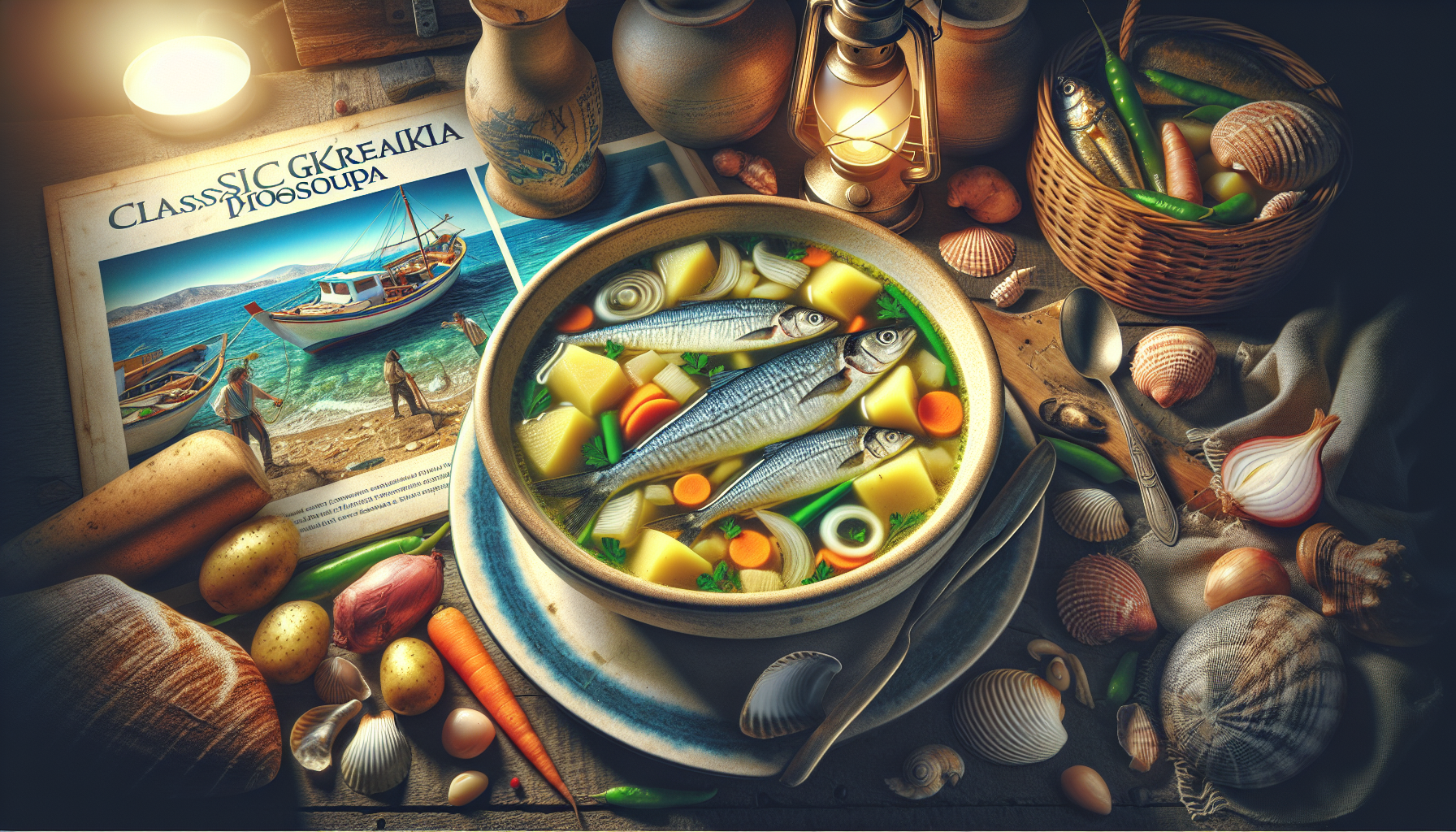Classic Greek Psarosoupa: A Taste of the Aegean
As we embark on this culinary journey through the sun-soaked Aegean, one dish stands out for its simplicity, depth of flavor, and heartwarming properties: Classic Greek Psarosoupa. This traditional fish soup is not just a delicious recipe; it’s a celebration of the Mediterranean way of life, capturing the essence of fresh ingredients and vibrant flavors. Whether you’re a seasoned chef, a busy parent looking for a wholesome meal, or simply someone who enjoys the soothing properties of a warm bowl of soup, this recipe will surely become a staple in your kitchen.
The Allure of Psarosoupa
Psarosoupa holds a special place in Greek cuisine, revered not only for its comforting flavors but also for its health benefits. This dish is brimming with omega-3 fatty acids, vitamins, and minerals, making it an excellent choice for those seeking nutritious meal options. The aromatic broth enlivens the senses while the tender fish provides substantial protein, making Psarosoupa a perfect meal for both lunch and dinner.
Kitchen Equipment Needed
Before diving into our delightful recipe, let’s ensure you have all the necessary kitchen equipment ready.
- Large pot or Dutch oven
- Cutting board
- Sharp chef’s knife
- Wooden spoon or ladle for stirring
- Measuring cups and spoons
- Soup ladle for serving
- Blender or immersion blender (optional for a smoother consistency)
- Chef’s apron (to keep things tidy!)
Ingredients for Classic Greek Psarosoupa
To create this aromatic and hearty soup, you will need the following ingredients:
- 1 kg of whitefish (such as cod, haddock, or sea bass)
- 2 medium onions, finely chopped
- 2 carrots, diced
- 2 stalks of celery, diced
- 3 large potatoes, peeled and cubed
- 3-4 cloves of garlic, minced
- 1-2 tomatoes, chopped (or 1 cup of canned diced tomatoes)
- 6 cups of fish broth or water
- ½ cup of olive oil
- Juice of 1 lemon
- Fresh dill, chopped (for garnish)
- Salt and pepper to taste
Cooking Directions
Follow these simple steps to create your own Classic Greek Psarosoupa:
Prepare the Fish: Start by cleaning the fish if it’s not already filleted. Rinse under cold water and pat dry with paper towels. Cut the fish into large chunks, and set aside.
Create the Base: In a large pot or Dutch oven, heat the olive oil over medium heat. Add the chopped onions and sauté until they become translucent. This will take about 3-5 minutes.
Add Aromatics: Next, incorporate the diced carrots, celery, and minced garlic. Sauté for another 5 minutes, allowing the flavors to meld.
Introduce the Broth: Pour the fish broth or water into the pot, followed by the cubed potatoes and diced tomatoes. Bring everything to a gentle boil, then reduce the heat and allow it to simmer for about 15-20 minutes, or until the potatoes are tender.
Add the Fish: Gently place the fish chunks into the simmering broth. Cook for another 8-10 minutes until the fish is cooked through and flakes easily with a fork.
Season and Serve: Stir in the lemon juice, and season with salt and pepper to taste. For a touch of freshness, garnish with chopped dill before serving.
- Enjoy: Ladle the soup into bowls and serve warm with crusty bread or a side of Greek salad.
Storage Tips for Leftovers
If you find yourself with leftovers—a rare but delightful occurrence—you can store your Psarosoupa in airtight containers in the refrigerator for up to three days. If you want to keep it longer, consider freezing it in portions. Just be sure to allow it to cool completely before transferring to freezer-safe containers. To reheat, thaw in the refrigerator overnight and warm gently on the stovetop.
Variations and Recipe Swaps
While the Classic Greek Psarosoupa is delicious as is, here are a few variations to consider:
- Fish Options: Feel free to mix and match the types of fish you use. Other options include tilapia, snapper, or even shrimp for a seafood medley.
- Vegetarian Version: To create a hearty vegetarian version, simply omit the fish and use a variety of veggies like cauliflower, zucchini, and bell peppers, while maintaining the same broth for flavor.
- Spicy Kick: If you enjoy a bit of heat, add a pinch of red pepper flakes or a dash of hot sauce while cooking.
- Herb Variations: While dill is traditional, you can experiment with thyme, parsley, or even rosemary to give the soup a new twist.
Food and Drink Pairings
To elevate your dining experience, pair your Classic Greek Psarosoupa with a side of crusty artisan bread for dipping. A light and refreshing Greek salad featuring cucumbers, tomatoes, red onion, olives, and feta will complement the soup perfectly.
For drinks, a chilled glass of white wine, such as Assyrtiko or Sauvignon Blanc, enhances the flavors beautifully. If you prefer non-alcoholic options, a lemon-infused sparkling water adds a refreshing touch.
FAQs About Psarosoupa
What type of fish should I use for Psarosoupa?
The best choices are firm white fish like cod, haddock, or sea bass. You can also use fresh seafood for added flavor.
Can I make Psarosoupa in advance?
Absolutely! This soup actually tastes better the next day as the flavors meld. Just ensure you store it properly.
Is Psarosoupa gluten-free?
Yes, this soup is naturally gluten-free, making it a suitable option for those with gluten sensitivities.
Can I add other vegetables to Psarosoupa?
Certainly! Other vegetables such as bell peppers, zucchini, or even leafy greens like spinach can be excellent additions.
How can I make the soup creamier?
For a creamier texture, blend a portion of the soup before adding the fish, or stir in a splash of cream or coconut milk just before serving.
Conclusion
Classic Greek Psarosoupa is more than just a dish; it’s a moment of tranquility, a taste of the sea, and a nourishing experience that connects you to the Aegean. Perfect for family dinners or cozy nights in, this beloved recipe showcases the beauty of simple, wholesome ingredients.
As you bring this delightful soup into your kitchen, we invite you to share your experience and any personal twists you may add. Don’t forget to subscribe to our blog for more exciting recipes and culinary tips from around the world!
Happy cooking!

















